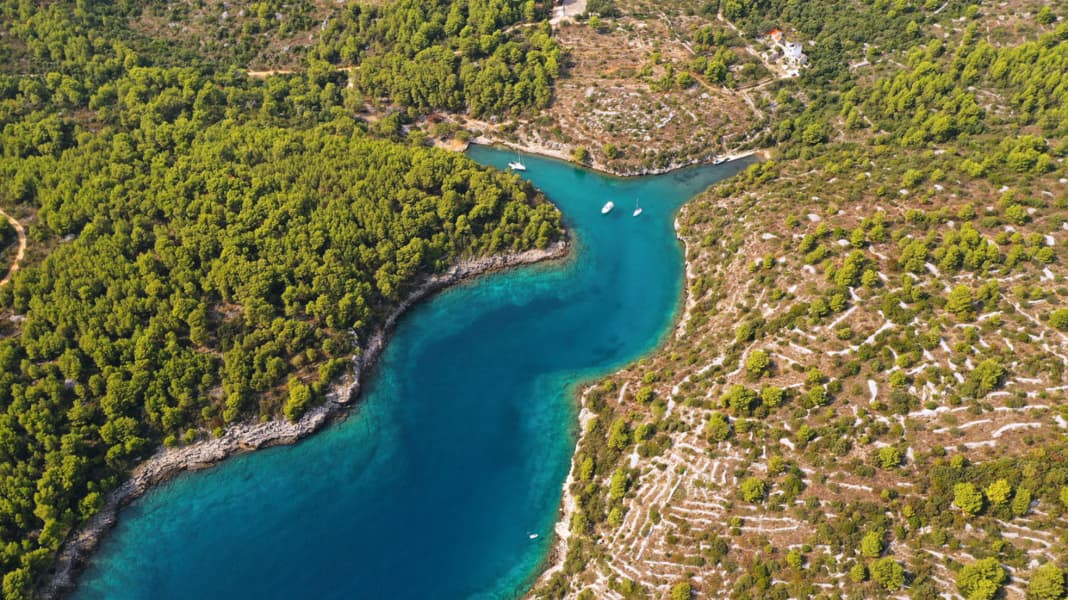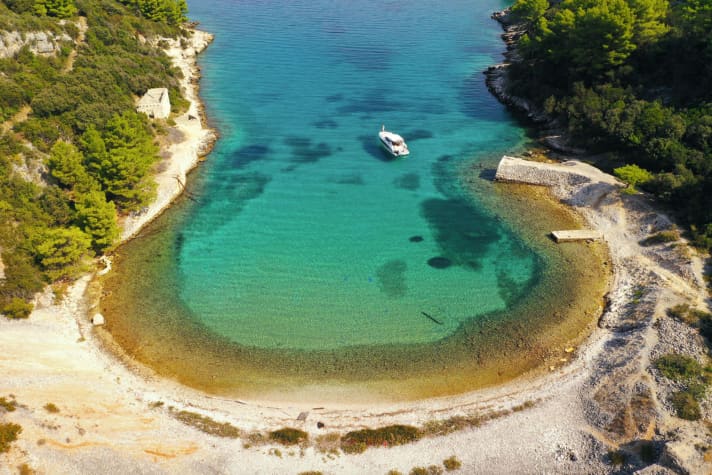
We pick up our charter boat at the Blue Nautica base in ACI Marina Trogir. The young company not only rents out motorboats, but also offers a full range of diving services and operates its own diving centre in Jelinak Bay, three miles away. At the same time, Blue Nautica is a sought-after company as a
Rescue Diver, which is able to rescue boats and ships from depths of up to 100 metres. From the very first moment, we have the feeling that there are people at work here who are very familiar with the sea.

Our charter boat, a Jeanneau Leader 36, is two years young, looks like new and is in top technical condition. The sky is bright blue, the mercury is 33 degrees and there is a light maestral, the fair weather wind on the Adriatic. And it's set to stay that way for the next few days. Fantastic conditions for a charter cruise on the Adriatic.
Need more information? The travel report on Central Dalmatia with many more pictures and a service section can be found in BOOTE issue 08/2021 from 14 July 2021 at newsstands or online at Delius Klasing Shop.
The beginning of September is still high season in Croatia. The jetties in the marina are much fuller than usual at this time of year. In particular, many sailing yachts from large charter companies, which are normally out and about during the season, are moored in the harbour. Corona has had a visible impact on the charter industry on the Adriatic. But the Croatians are as relaxed and friendly as ever. They have got used to wearing masks when shopping. Otherwise, not much has changed. The outdoor catering - in summer you always sit outside in Croatia - is open, the wine tastes good and the sun is shining. What more could you want?
Our cruise planning is still very vague. Of course, the coronavirus infection figures play a role. In Croatia, it's mainly the big cities that are affected. But what about the islands? What is the situation in such enchanting old towns as Milna, Hvar or Stari Grad? Tourists from all over the world are travelling there. Can you be safe from the virus there?
We ask company boss Joško for advice. He thinks for a moment, gets up and goes to his base. He comes back carrying a heavy load. "I'll give you two sets of diving equipment. Snorkels, masks and fins are on board anyway." With a wink, Joško says: "There's no coronavirus underwater." "Where should we go?" "If you want to be completely safe, avoid all towns. Look for the most secluded bays. There are hundreds of them around Brač and on the north coast of Hvar. Many are uninhabited, some are inhabited by hermits. There is no corona there."
We buy a week's worth of groceries at the ACI Marina mini-market. It's only slightly more expensive than in a large supermarket, but we can push the shopping trolleys right up to the boat. We pick up fresh fruit and vegetables from the nearby weekly market on the northern edge of the old town. It looks the same as always here, but relatively few foreigners are shopping. You can recognise them by their masks.
With 550 litres of diesel in the tank, we are well equipped for the week. Only the fresh water tank is not particularly large at 160 litres. Small fresh water tanks are typical of many French boats, as they usually return to their own moorings in the evening. But that shouldn't be a problem in Croatia.
We start our trip in seven days of solitude in fantastic weather and well equipped. We leave Trogir astern and then head south-east towards Cape Gomilica on the north-western tip of the island of Brač. About a mile south of the cape is Stipanska Bay, where the iron falls for the first time. We head east along the north coast of Brač, consistently skipping all the towns and discovering many secluded and beautiful bays. Unfortunately, our fresh water tank is almost empty after two days. To avoid having to go to a town harbour, we head for the municipality of Mimice on the mainland coast. There are only a few local fishing boats moored there and a small excursion boat at the short pier. We go alongside. Young people jump into the water on the pier and then rinse themselves off with a hose from a public tap. The captain of the excursion boat helps to extend the hose until it reaches our boat.
With a full water tank, we continue our trip around Brač, round Cape Lašćatna and discover a number of picturesque anchor bays, each more beautiful than the last, in a very confined space. We sail along the north coast of Hvar to the island of Sveti Klement to bunker up with water in the ACI Marina Palmižana. From Soline Bay, we set off on our journey home to Trogir. Seven days of solitude was one of the most beautiful Croatian cruises we have ever experienced.

Need more information? The travel report on Central Dalmatia with many more pictures and a service section can be found in BOOTE issue 08/2021 from 14 July 2021 at newsstands or online at Delius Klasing Shop.
Stipanska:The popular anchorage in the north-west of the island of Brač offers good protection from all winds. If several boats anchor here, it is advisable to set up a shore anchor. There is not yet a konoba.
Lovrečina:We have the beach almost to ourselves. Lovrečina Bay is located on the north coast of Brač between Postira and Pučišća. The remains of the basilica of St Lawrence from the 5th century stand on the shore. The Lovrečina restaurant is just a few steps from the beach.
Konopjikova:A small paradise has remained where white stone was once quarried and shipped. Konopjikova Bay lies one nautical mile east of Lovrečina. You can anchor at a depth of 3.5 metres between the former loading bridges.
Mimice: The tiny fishing harbour is located on the mainland coast. There are no guest berths, but you can bunker water for free at the bathing area at the pier head, simply go alongside the excursion boat.
Luka: The largest bay on Brač cuts deep into the land and offers shelter in all weathers. The Pipo and Rojen konobas are located at the western end and offer excellent regional cuisine.
Rasotica:The deeply incised fjord lies at the eastern end of Brač, below Cape Lašćatna. There is no infrastructure and no service. If you drop the iron here, you have a lonely bay. At Jugo, swell rolls into the bay and you should leave it.

Studena:The bay lies just under 2 nm southwest of Sumartin and is a popular day anchorage for swimming and snorkelling. It offers no shelter in southerly winds or swell. There is a hermitage on the shore that is inhabited in summer, but no taverna.
Špiljice:Picturesque bay on the south coast of Brač, about 2 nm west of Studena. Secluded sandy beach with crystal-clear water. The stone house on the western cape of the bay is a summer house, not a konoba. No shelter in southerly winds and swell.
Hrvaska: One of the most beautiful places on the south coast of Brač. Konoba Vala Hrvaska serves fresh catch and organic agricultural produce. Five mooring places for small boats and three buoys for yachts. Book in the season: Tel. +385-91-931 5241.
Mala Stiniva: Two-armed bay on the north coast of the island of Hvar. The western arm (photo) is picturesque, but offers too little space for anchoring and no possibility of mooring. The eastern arm is good for anchoring, except in northerly winds.
Žukova: A very sheltered and picturesque bay on the north coast of the island of Hvar. The anchor holds well on the sandy bottom. There are a few old stone houses on the shore, some of which are inhabited in summer. However, there is no konoba, so enjoy the incredible silence and solitude!
Palmižana:The less busy ACI Marina Palmižana remains astern. We spent a night here to stock up on water and recharge our batteries. An evening at the top Palmižana Meneghello restaurant was also included.
Soline: To the west of the island of Hvar is the Sveti Klement archipelago with its countless bays. One of the most beautiful is Luka Soline, where you can anchor or tie up to buoys. The Paradiso, Fishermans House and Dionis restaurants are just a few steps from here. The excellent Colnago winery is located in Vlaka Bay in the north.

